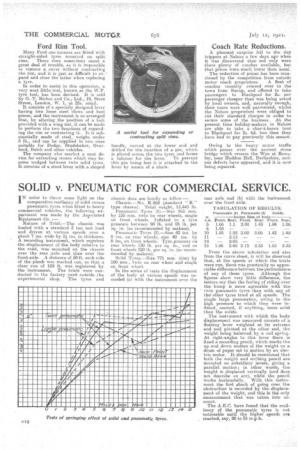SOLID v. PNEUMATIC FOR COMMERCIAL SERVICE.
Page 8

If you've noticed an error in this article please click here to report it so we can fix it.
IN order to throw some light on the comparative resiliency of solid versus
pneumatic tyres when fitted to heavy commercial vehicles, the following ex, pe,riment was made by the Associated Equipment Co.
Nature of Trial.—Tho chassiswas loaded with a standard 3 ton test load arid driven at various speeds over a plank 7 ins, wide by 2i ins, in thickness. A recording instrument, which registers the displacement of the body relative to the road, was mounted on the chassis over the rear axle and. then over the front axle. A. distance of 50 ft. each side of the plank was marked out., so that a clear run of 100 ft. was registered by the instrument.. The trials were conducted in the factory yard outsidethe experimental shop. The tyres and
chassis data are briefly as fellow :— Chassis.—No. K.868 (standard " K " type chassis). Total weight, 13,440 lb.
Pneumatic Tyres (1).—Size 955 nom. by 155 mm. twin On rear wheels, single on front wheels. Inflated to a tyro pressure between 90 lb. and 95 lb. per sq. in. (as recommended by makers).
Pneumatic Tyres (2).—Size 42 ins, by 9 ins, on rear wheels, size 40 ins. by 8 ins, on front wheels. Tyre.pressure on rear wheels 130 lb. per sq. in., and OR front wheels 120 lb. per sq. in. (as recommended by makers).
Solid Tyres.—Size 771 nom. (rim) by 100 mm., twin on rear wheel and single on front wheel.
In the series of tests the displacement of the body at various speeds was recorded (al with the instrument over the rear axle and (h) with the instrument over the front axle: TABULATION OF RESULTS:
Pneumatic it) teiterimates (2) Solidem. .-----Inebes Rise of Body. P.H, Front, Rear. Front. hear. Front. hear.
5 1.66 1.1 2.08 1.43 1-94 1.06
10 1.85 1.93 2.00 2.06 1.43 1.45
11 — 2.13 — — 14 -2.03 — — — 15 1.96 2.60 2.13 2.33 1.83 2.35 Prom the above tabulation arid also from the curve sheet, it will be observed that, at the speeds at which the trials were run, there was practically no appreciable difference between the performance of any of these tyres. Although the figures show very little difference, the testers say that the feeling of riding over the bump is more agreeable with the twin pneumatic tyres than with any of the' other tyres tried at all speeds. The single large pnemnaties:•, oWing to the high pressure to which they were inflated, 'seemed, if anything, more solid than the solids.
The instrument -with which the body displacement was measured consists of a floating lever weighted at its extreme -end and pivoted at the other end, the weight being balanced by a coil spring. At right-angles to this lever there in fixed a recording pencil, which marks the up and down motion of the weight on a drum of paper set in motion by an electric motor.It should be mentioned that both the weight and scribing pencil are mounted on subsidiary levers, giving a parallel motion; in other words the weight is displaced vertically (and does not describe an arc), while the pencil works: horizontally. With this instrument the first shock of going over the obstruction is recorded by the displacement of the weight; and this is the only measurement that was taken into account.
The A.E.C. have found that the resiliency of the pneumatic tyres is not noticeable until the higher -speeds are reached, say, 20 to 25 m.p.h.
































